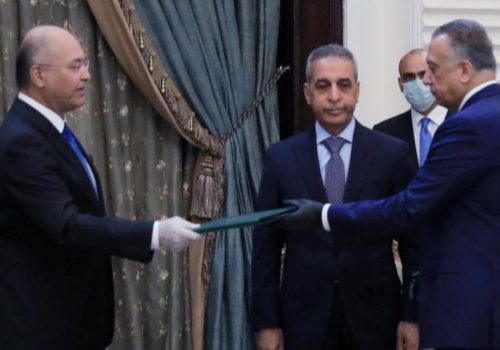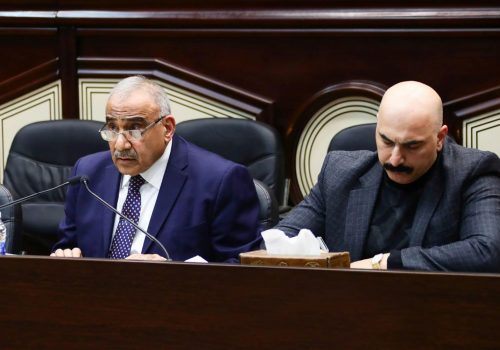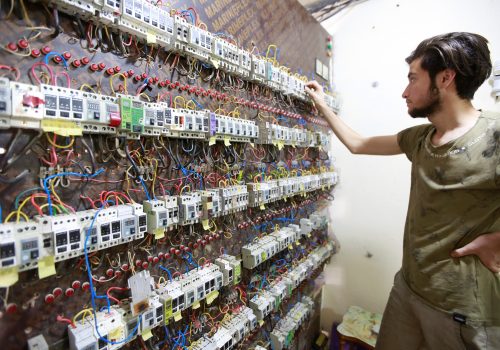To move forward, US policy on Iraq requires balancing confrontation with Iran
The United States’ policy toward Iraq is frequently criticized for lacking clarity or for failing to adequately align means to ends. These criticisms are not entirely fair. Summarizing the Strategic Framework Agreement, which is still the foundational document for US-Iraq relations, the United States has set a democratic, prosperous, and unified Iraq as its objectives. Furthermore, since 2003, the US has resourced political, economic, and security efforts to achieve those goals. During the US occupation (2003-2011), the US provided approximately $49 billion in total assistance, including more than $8 billion toward humanitarian assistance and stabilization. Since the fight against the Islamic State of Iraq and al-Sham (ISIS) began in 2014, the US has provided an additional $10 billion in total assistance. The problem is not clarity or resourcing.
However, given that Iraq is now on the brink of political and economic collapse while Iraqis are protesting to remove US forces in Iraq—even while the fight against ISIS continues—there is something unworkable about these goals and the means used to achieve them. Underscoring that point, protestors in November of last year reportedly chanted, “Are you Iranian? No. Are you American? No! Are you Baathist? No? Are you Iraqi?” The cheering was deafening in response to that last question. While a sense of national identity is a good thing, the fact that Iraqis hold the US morally equivalent to Iran and the Baathists is not.
The incommensurability of US policy on Iraq
The problem for the United States’ Iraq policy is that its objectives are incommensurate with goals relative to Iran. A democratic, prosperous, unified Iraq—especially one aligned with the US—incentivizes Tehran not only to increase its influence but to diminish the US’s. Additionally, Tehran exploits Iraq’s corrupt political culture and sectarian divisions to undermine recovery and ensure that Iraq does not become a threat as it was in the 1980s. In effect, US policy toward Iraq, particularly when subordinated to its policy toward Iran, is like trying to draw a square circle—doing so is impossible. One has to choose which to draw first: square or circle.
The failure to choose has resulted in a zero-sum game where any meaningful progress on Iraq’s recovery, reconciliation, and economic development is held hostage to US-Iran relations. Moreover, increasing pressure on Tehran does not help—it just increases the price Tehran is willing to pay, as Iraq plays a central role in Iran’s national security.
Squaring the circle
So, which to choose: square or circle? Prioritize rolling back Iran’s regional influence or prioritize Iraq’s recovery? Focusing on the former will likely risk more confrontation with Iran and its proxies as they escalate efforts to limit, if not eliminate, US influence in the region. Turning to the latter risks emboldening Iran elsewhere in the region as well as undermining relations with Arab partners who benefit from the current confrontation.
While the protests have shown that Iraqis of all stripes are tired of Iran’s influence, they have also shown that there is little that they can do about it. More precisely, while the protests may have moderated Iran’s influence in some areas, they have not diminished its ability to mobilize the parliament and people against US interests, even when those interests align with those of the protesters. In response, the US could escalate its current confrontational approach, which would have a high payoff it if worked. Moreover, Tehran sometimes responds to displays of strength and often moderates its response to avoid further escalation. So, it would be wrong to dismiss its chances of success as nil.
Nonetheless, its odds are complicated because demanding Iran to unilaterally abandon its nuclear and ballistic missile programs effectively asks it to disarm in what it perceives to be a very dangerous neighborhood. It is hard to conceive of a cost the regime would not pay to avoid conceding to these demands. That is the problem with the current confrontational approach: it is not just unclear if it will work, it is unclear how it will work. Tehran gets to decide how much costs it will bear and it is not clear that the US can impose it.
Prioritizing Iraq’s recovery, on the other hand, comes with its own risks. While it is fairly clear how it would work, it is not clear if it will work. Iraq’s recovery depends on well-identified political, economic, and other reforms. However, while these reforms are in the interest of Iraq at large, they are not always in the interest of individual Iraqis or the political parties that claim to represent them. As a result, though there is significant popular support for reforms generally, there is often little political support for particular reforms. Only Iraqis can break this impasse.
So, under current conditions, US options are limited. That means its objectives must be as well. In the short term, the United States needs Iraq to accept a US presence—whatever form that takes—and be willing to resist Iranian attempts to push the United States out. Doing so requires a two-pronged approach. First, the US must bolster the Iraqi government’s ability and will to resist Iranian pressure to place limits on US-Iraq engagement. Necessary to achieving that goal is continued humanitarian and stability assistance. Additionally, the US needs to amplify the effects of that assistance through high-level key leader engagements to assure Iraqi leaders of US commitment, while stepping up efforts to provide financial and economic reforms.
The US must also consider ways to take pressure off of Prime Minister Mustafa al-Kadhimi’s government. As a first step, the US should accommodate whatever troop reductions are necessary to relieve parliamentary and public criticism. The current troop presence has already been largely reduced to an advisory group that has consolidated its operations and focused its advisory effort at the Iraqi Security Forces (ISF) directorate level. Moreover, much of the advising has been limited due to COVID-19. So, while the premature removal of this support may diminish Iraqi military capabilities, what matters in the long term is an enduring security relationship and an ability to rapidly reinforce the ISF should or when the Islamic State of Iraq and al-Sham (ISIS) returns.
Maintaining an ability to rapidly reinforce the ISF can be accomplished through Title 10 military exchanges that emphasize interoperability and sustain relationships with the organizations responsible for providing and receiving that support. Since Title 10 exchanges can be conducted by units stationed outside of Iraq, none would count as continued troop presence.
As a second step, the US needs to improve its perception among the Iraqi public by doing more to promote its non-military support and counter the Iranian narrative of US duplicity. Right now, most of what Iraqis see is military assistance, even though 85 percent of US assistance was directed at humanitarian relief, stability, and improving governance in 2019. Of that 85 percent, the US provided more than $500 million in non-military assistance and remained the largest donor to the UN-administered Funding Facility for Stabilization.
Furthermore, the US must convince Iran that the cost of opposing its presence in Iraq is too high. While it may be impossible to determine what Tehran’s price for surrender is, it should be possible to find and meet their price for accepting a US presence in Iraq. This can be accomplished by signaling that the cost of accommodating a US presence will be low, not just by communicating that the cost of continued resistance will be high.
The US has effectively done the latter by conducting strikes against Quds Force commander Qasem Soleimani, Popular Mobilization Forces commander Abu Mahdi al-Muhandis, and other Kataib Hezbollah facilities. The difficulty with this approach, as discussed, is that it results in increased pressure for the US to leave. Thus, in the long term, it may be self-defeating—at least without offering alternatives acceptable to Tehran. So, while US forces should always retain the right to defend themselves, the US government should look for alternate means to impose costs and avoid future unilateral use of military force inside Iraq.
As a necessary condition, the US must ensure its troop presence does not signal a threat to Iran, absent requirements for self-defense. Of course, convincing the Iranians that the US presence in Iraq is not a threat while being so elsewhere is a tall order. This is where prioritizing Iraq’s recovery requires biting the bullet and accepting some political risk. Convincing Tehran to accept a US presence in Iraq will require a more accommodating approach to US-Iran relations and willingness to negotiate on some matters of importance to the Iranian regime.
Doing so will invite considerable criticism, both domestically and from the United States’ other partners in the Middle East. Moreover, accommodating Tehran risks giving it a freer hand to engage in destabilizing activities. Its use of proxies and other deniable means would make it difficult to hold the regime accountable should it use such methods to oppose the US presence. For that reason, any accommodation, even on current sanctions, should be limited in nature and contingent on verifiable concessions by the Iranians.
Which accommodations are effective may be difficult to discern. Re-engaging the Iranians on the Joint Comprehensive Plan of Action (JCPOA) will likely be insufficient. Not only did the US withdrawal from the agreement embolden hardliners in Iran who were skeptical of the deal, its limited sanctions relief gives moderates little justification to return. To be clear, there is nothing wrong with trying to get JCPOA talks restarted—the US will just have to look for other ways to incentivize Tehran regarding Iraq.
Sanctions relief is a more tangible alternative. Needless to say, any relief will also raise concerns that Iran will use the additional resources to further destabilize the region. That is a reasonable concern, but, given the poor economic conditions exacerbated by the coronavirus pandemic, Tehran will likely have to prioritize additional resources to social and economic concerns. Nonetheless, the US could signal a willingness to reduce tensions by removing recent sanctions on certain banks that allow Iran to import medical supplies more easily. Obviously, any additional relief should be conditioned on specific behaviors, such as ceasing attacks on US forces and facilities in Iraq. Over time, and as conditions change, the US should look for opportunities to gain other concessions as well.
Bargaining creates opportunities
Writing during the Cold War, Thomas C. Schelling argued that the power to hurt was the power to bargain. He also posited that the purpose of bargaining was to create opportunities for cooperation, even among an adversary like the Soviet Union. This is the approach argued for here. The US should not take the power to hurt Iran off the table. However, if Washington wants to shape Iranian behavior relative to Iraq—or anywhere for that matter—it has to give Tehran alternatives it can accept.
Making US objectives in Iraq more workable requires making some hard choices and taking some significant risks. However, so does maintaining the status quo, which eventually ensures diminished US influence at great expense. Making these choices does not mean that the US has to abandon its goals relative to either Iran or Iraq. It just means prioritizing one while managing risks to the other in order to give Iraq the resources and, more importantly, the space it needs to realize the shared objectives of becoming democratic, prosperous, and stable.
Dr. C. Anthony Pfaff is a nonresident senior fellow with the Atlantic Council’s Iraq Initiative and research professor for Strategy, the Military Profession, and Ethic at the US Army War College’s Strategic Studies Institute. The views expressed here are those of the author and not necessarily the US Government.
Image: A supporter of Hashid Shaabi (Popular Mobilization Forces) holds a picture of late Iran's Quds Force top commander Qassem Soleimani and Iraqi militia commander Abu Mahdi al-Muhandis who were killed in a U.S. airstrike during a protest in Baghdad, Iraq October 17, 2020. REUTERS/ Thaier Al-Sudani


